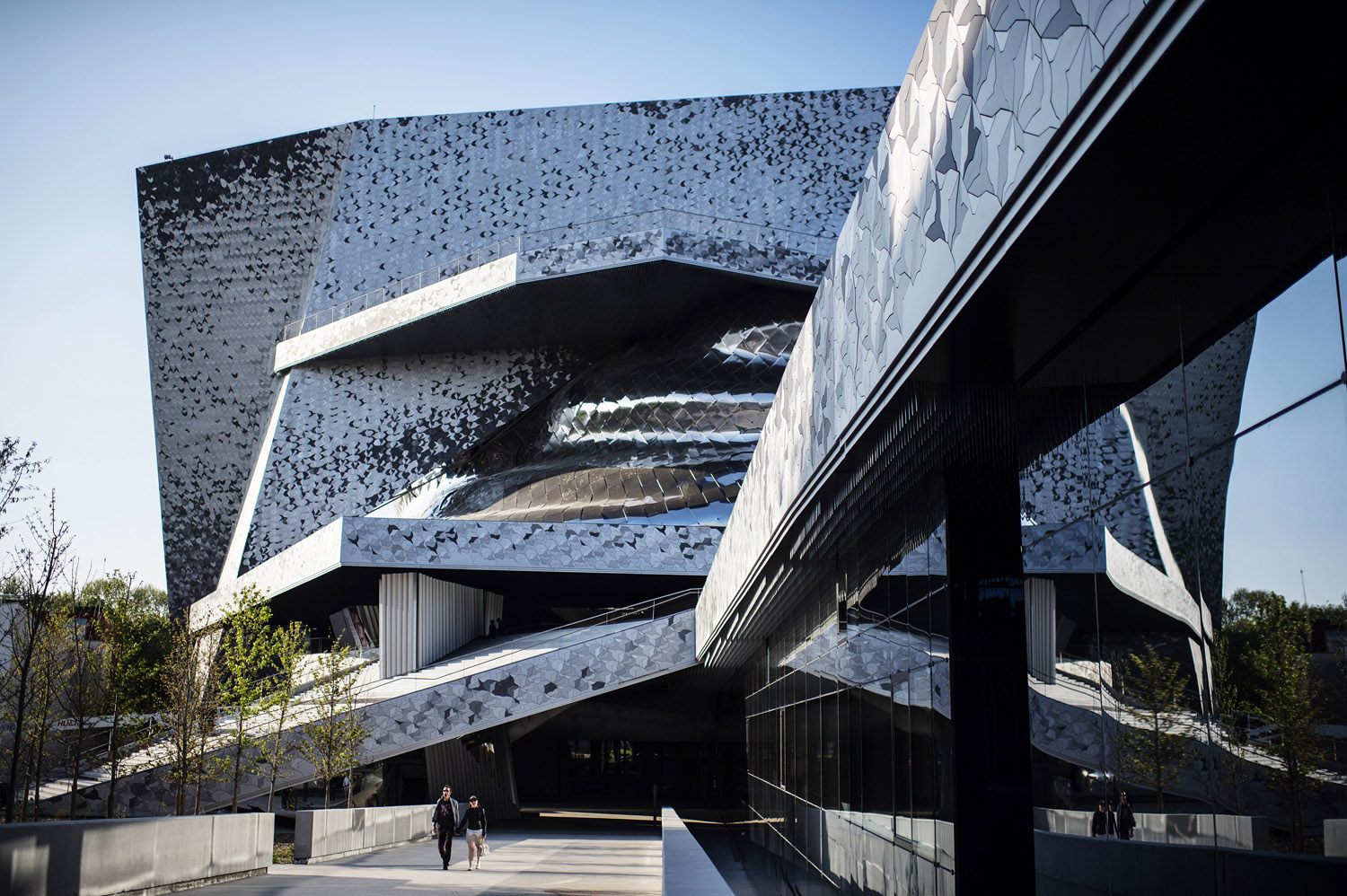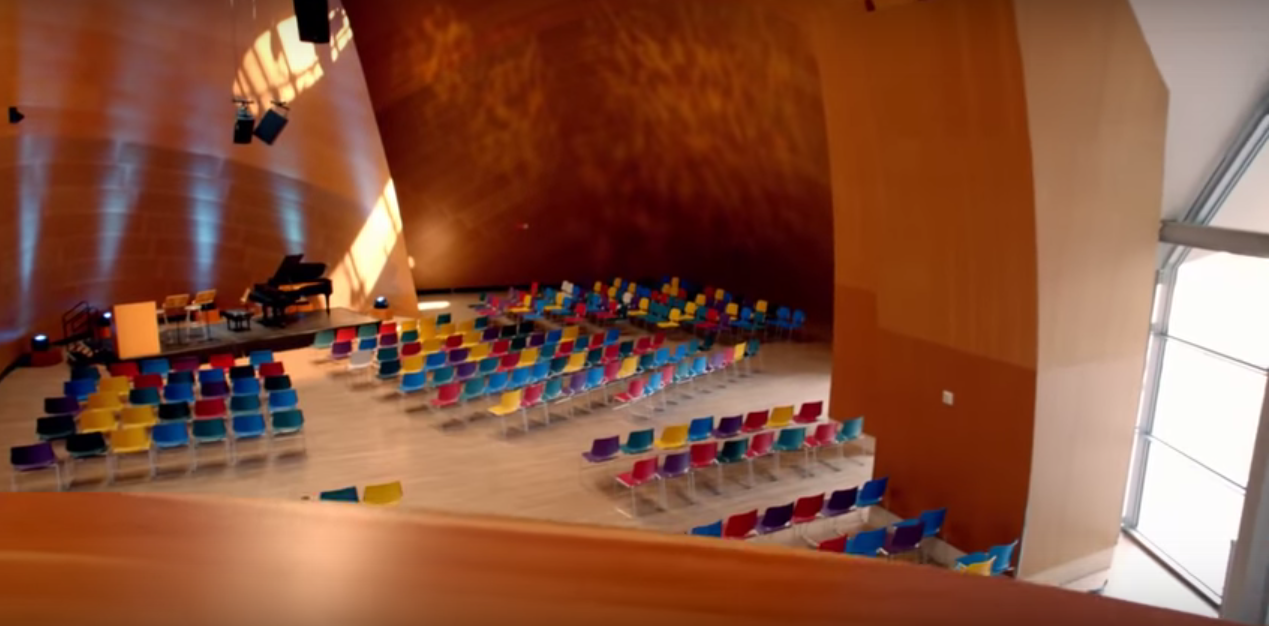
VENUES: THE PHILHARMONIE DE PARIS –
GRANDE SALLE PIERRE BOULEZ
by Alex Davydovich (MGBH)
Located in the Parc de la Villete at the northeastern edge of city is the Paris Philharmonic, or, as the locals call it, Philharmonie De Paris. It consists of two parts that compliment each other – Philharmonie 2, originally named the City of Music, and Philharmonie 1, the newest addition to the complex. Philharmonie 2 opened its doors back in 1995 and was originally called the City of Music, or le Cite de la Musique. Part of François Mitterrand’s (OBM) Grands Projets, the Cité de la Musique reinvented La Villette – the former slaughterhouse district.
While both structures are interesting and host an impressive amount of inspiring and uplifting cultural events, our overview will focus on Philharmonie 1 and its Grand Hall, or Grand Salle, Pierre Boulez (OBM), named after a prominent 20th century French composer. (Note: To avoid confusion, there is another Pierre Boulez Hall, or Boules Zaal, designed by the famous architect Frank Geahry (MGBH), located in Berlin, Germany).
Please, consider donating a small amount to the author to express your appreciation.

The credit for the idea of creating this marvelous addition to the City of Music should be given to the Minister of Culture and Communications Renaud Donnedieu de Vabres (MGBH), The Mayor of Paris Bretrand Dehnoe (MGBH), and The Director of The Cite de la Musique Laurent Bayle (MGBH) who announced it back in 2006. As the result, an international competition among the finest architects had been held.
A year later, in 2007, a world-class architect Jean Nouvel (MGBH), who previously designed the Lucerne Culture and Conference Centre, Copenhagen’s Koncerhuset, and the Louvre Museum in Abu Dhabi, won the competition. This is part of his vision that he presented in his proposal:
“The word “philharmonic” easily brings to mind the love of harmony. We play successive harmonies –urban harmonies. … First, harmony with the lights of Paris, a ray of sun among grey clouds and rain. An architecture based on measured, composed reflections, created by way of a tranquil surface in the form of cast aluminum cobblestones that sketch out Esherian graphics under our feet. Second, harmony with the Parc de la Villette, the continuity of Tschumian themes, a horizontal garden shelter under the building, punctuated by “Tschumi’s follies”, shadows reflected in the architectural brilliance and the creation of a small hill –La Villette Hill– a walkable mineral surface which, like the Buttes-Chaumont, plays the role of an observatory, looking out over the urban landscape. Third, harmony with the Cité de la Musique with oblique sections and paving of force lines that were already there. Fourth, harmony with the city’s ring road and suburbs, with the creation of a sign providing a dynamic and far-reaching view; a shimmer of light in the darkness of night, punctuating the Philharmonie’s surface and its programs….The Philharmonie de Paris <…> is supported in this endeavor by powerful but serene aesthetics, marked by the single use of cast aluminum, with its pearly nuances and delicateness, adding to the mystery of the hall’s presence which, in the grey and silver folds of the building, shines through.” (1)
The project took much longer to complete than expected. It went over budget by over a hundred million dollars. However, both the wait, the effort, and the money were worth it. This stunning masterpiece was finished and opened its doors in January of 2015.
During its first season, Philharmonie 1 attracted such outstanding pianists as Martha Agrerich (MGBH), Daniel Barenboim (MGBH), Helene Grimaud (MGBH), and Maurizio Pollini (MGBH).
In 2016, during its 2nd season, Daniel Barenboim and Martha Agrerich came back to perform there and were joined by Christian Zacharias (MGBH), Nicholas Angelich (MGBH), Murray Perahia (MGBH), Alexandre Tharaud (MGBH), Maria Joao Pires (MGBH), Yuja Wang (MGBH), Nelson Freire (MGBH), Andras Schiff (MGBH), Maurizio Pollini (MGBH), Lang Lang (MGBH), and Mitsuko Uchida (MGBH).
INSIDE…….
The Pierre Boulle Grand Hall seats 2,400 people. The seats themselves were particularly designed to ensure the audience’s comfort: the distance between seat rows is at least 90 cm, and all seats are 52 to 55 cm, i.e. 20.5-21.5 in. wide. Although large in size, the hall feels remarkably intimate. This feeling can be mathematically explained: the distance between the conductor and the farthest spectator is only 32 meters. The hall’s organic shapes and the warmth of the wood create an ambiance conducive to taking in music. One listens better in a state of well-being; such is the “psycho-acoustic” postulate of the Philharmonie. This is why certain materials are more present than others, even if they do not necessarily contribute to the quality of sound. (2)
Below you can see the chart of the Grand Salle Pierre Boulez.

One of the features that makes the Philharmonie unique among European concert halls is its versatility. The aim was to be able to adapt the auditorium to different genres of music, while always providing optimal viewing and listening conditions.

In the symphonic configuration, the audience surrounds the orchestra. The tiers behind the stage can accommodate a choir if required for the work being presented, but are more often filled by spectators. These seats are popular with music aficionados, who enjoy the proximity to the musicians and being in front of the conductor. (3)

But in the case of concert-format operas or “ciné- concerts”, these seats are not used. The modular concept allows these back tiers to be eliminated and the stage to be moved back, increasing the parterre. (4)
Another innovative feature is that the seats in the parterre can be removed to leave standing room for contemporary music concerts, increasing capacity from 2,400 to 3,650 people.

An audacious system of balconies based on cantilevers and clouds was a teamwork between Jean Nouvel, Marshall Day Acoustics and Ducks Scéno. The 283 m² stage featuring motorized platforms can accommodate any orchestral ensemble, even the most imposing. (5) In addition to the local team, the architect employed the services of a renowned acoustics specialist Yasuhisa Toyota (MGBH) from Japan, who also worked on the Walt Disney Concert Hall in Downtown Los Angeles, CA. The acoustic program (prepared by Kahle Acoustics) required an acoustic response that combines high sound clarity and ample reverberation. It also required an approach that favors lateral reflection and great intimacy – and in a new type of venue. The solution found was a daring system of floating balconies that create an intimate space and an exterior volume that prolongs the reverberation. This new model combines lateral reflections, direct sound and reverberation, resulting in high clarity and transparency, as well as warm resonance. The cloud-shaped reflectors, the back walls of the balconies and the parterre walls all contribute to this lateral reflection “envelope.”
The hall is soundproofed from the outside noise through the “box within a box” concept by leaving space between the walls. With the combination of two spaces that fit into each other, an interior floating room hosts the audience, creating visual and acoustic intimacy between the audience and the musicians and an outer space with its own acoustic and architectural presence. An innovation that is simultaneously architectural, scenographic and acoustic. The architect and the hall’s main acoustic consultant, Sir Harold Marshall, designed this hall in collaborative sessions focused on combining architecture, acoustics, and scenography. (6)

The hall also houses a magnificent Rieger organ, 15 metres high and 20 metres wide, that was specially designed for the symphonic repertoire.
The season starts on September 1st featuring afternoon and evening performances.
One of the features unique to the Paris Philharmonie is that it offers free video concerts that are available online. Of almost 700 videos, including 50 full concerts. If interested to watch performances online, you can find them HERE by clicking the link.
…..AND OUT, or THE BIRDS
The exterior of the Philharmonie 1 is as amazing as its interior. Its covering is composed of 340,000 birds, divided into seven different shapes and four shades ranging from light grey to black. More than 200,000 birds in aluminum sheeting are installed on the facades to symbolize a grand take-off. To adorn the Philharmonie’s esplanade, the ramp and part of the main concert hall’s acoustic roofing, the ground pavement birds are designed in cast aluminum assembled on a pre-cut granite structure. Some of the pavement birds have been even moulded in concrete. (7)

All in all, the Philharmonie de Paris is a true destination. If you are visiting Paris, whether you are a music aficionado or just a curious tourist, it is definitely worthy of putting it on your list of “must go’s”. The concerts as well as educational programs are very reasonably priced, and by visiting the complex, you will experience the true spirit of Parisian cultural life.
References:
(1) Philharmonie De Paris. Online Press Kit.
https://philharmoniedeparis.fr/sites/default/files/dp_philharmonie_-_gb_-_final_0.pdf
(2) Ibid.
(3) Ibid.
(4) Ibid.
(5) Ibid.
(6) Ibid.
(7) Ibid.
Liked the article? Please, consider donating a small amount to the author to express your appreciation.
 Piano Performer Magazine
Piano Performer Magazine 

















